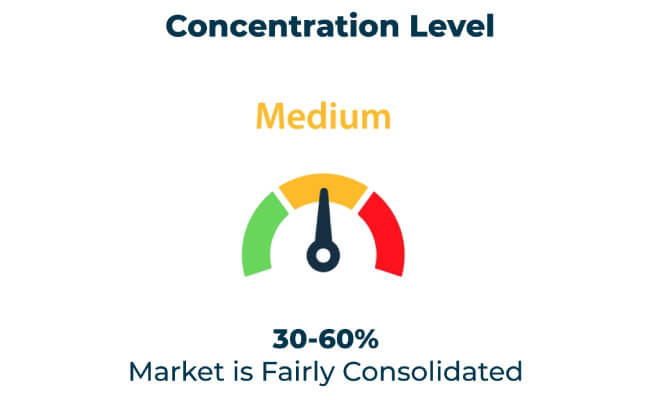Manufacturers are innovating in the bagasse packaging market due to the high demand for environmentally friendly alternatives to plastic. Among the leading companies are Ecoware, BioPak, and Huhtamaki, transforming sugarcane waste into compostable and durable packaging solutions for food, beverage, retail, and consumer goods industries.
| Attributes | Details |
|---|---|
| Projected Size, 2035 | USD 15 billion |
| Value-based CAGR (2025 to 2035) | 6.5% |
Advanced production technologies have been invested in by manufacturers for increasing the scalability, strength, and versatility of bagasse packaging. This enables companies to abide by the most stringent environmental regulations while meeting the needs of consumers to demand sustainable packaging.
A key driver is sustainability, as suppliers align their portfolios to corporate and governmental commitments toward reducing plastic waste. By developing cost-effective, compostable solutions, manufacturers ensure that bagasse packaging remains a viable and attractive option for a wide range of applications.
With a projected CAGR of 6.5% and an estimated market size of USD 15 billion by 2035, the bagasse packaging market seems to have considerable potential for growth, supported by regulatory momentum and ongoing advancements in product innovation.
Explore FMI!
Book a free demo
The bagasse packaging market gains momentum as businesses and governments prioritize sustainability. Unlike conventional materials, bagasse decomposes quickly, offering a solution to environmental challenges posed by plastic waste. New regulations, technological advancements, and corporate sustainability commitments fuel this growth.
Market Growth Drivers
Businesses adopt bagasse packaging for several compelling reasons:
Global Market Share & Industry Share (%)
| Category | Industry Share (%) |
|---|---|
| Top 3 (Ecoware, BioPak, Huhtamaki) | 30% |
| Rest of Top 5 | 15% |
| Next 5 of Top 10 Players | 10% |
Type of Player & Industry Share (%)
| Type of Player | Industry Share (%) |
|---|---|
| Top 10 | 55% |
| Next 20 | 25% |
| Remaining Players | 20% |

North America
Europe
Asia-Pacific
Emerging Markets
| Region | North America |
|---|---|
| Market Share (%) | 30% |
| Key Drivers | Stricter regulations and consumer demand for eco-conscious products |
| Region | Europe |
|---|---|
| Market Share (%) | 25% |
| Key Drivers | Leadership in sustainability innovation |
| Region | Asia-Pacific |
|---|---|
| Market Share (%) | 35% |
| Key Drivers | Ample raw materials and growing food service sector |
| Region | Other Regions |
|---|---|
| Market Share (%) | 10% |
| Key Drivers | Emerging markets embracing sustainable practices |
The bagasse packaging market will grow by addressing production inefficiencies and expanding applications in retail, healthcare, and food delivery. Businesses must leverage technology and partnerships to achieve cost efficiency and drive adoption across global markets.
| Tier | Key Companies |
|---|---|
| Tier 1 | Ecoware, BioPak, Huhtamaki |
| Tier 2 | Vegware, Be Green Packaging |
| Tier 3 | Regional and emerging manufacturers |
The bagasse packaging market represents a transformative shift toward sustainable commerce. Businesses that prioritize innovation and address production challenges will lead this sector’s future. Strategic collaborations and technological advancements will ensure bagasse packaging remains central to global sustainability efforts.
Key Definitions
Research Methodology
This report integrates insights from primary interviews, expert consultations, and market analysis validated with industry data.
The global bagasse packaging market will grow at a CAGR of 6.5% between 2025 and 2035.
The global bagasse packaging market will reach USD 15 billion by 2035.
The top 10 players account for approximately 55% of the global market.
Key manufacturers include Ecoware, BioPak, Huhtamaki, Vegware, and Be Green Packaging.
Nitrogen Flushing Machine Market Analysis by Automatic and Semi-Automatic Through 2035
Pan Liner Market Analysis by Polyethylene (PE), Nylon, Polypropylene, Polyester, Polytetrafluoroethylene (PTFE) and Biodegradable Plastics Through 2035
Perfume Filling Machine Market Analysis by Automatic Perfume Filling Machines and Manual Perfume Filling Machines Through 2035
Molded Pulp Packaging Machines Market Analysis - Growth & Forecast 2025 to 2035
Packaging Tensioner Market Analysis - Growth & Forecast 2025 to 2035
Packaging Films Market Analysis by Product Type, Material Type and End Use Through 2035

Thank you!
You will receive an email from our Business Development Manager. Please be sure to check your SPAM/JUNK folder too.